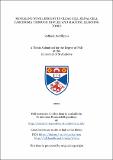Files in this item
Revealing novel insight in clear cell renal cell carcinoma through high-plex and machine learning tools
Item metadata
| dc.contributor.advisor | Harrison, David James | |
| dc.contributor.author | De Filippis, Raffaele | |
| dc.coverage.spatial | 195 | en_US |
| dc.date.accessioned | 2023-03-06T11:02:40Z | |
| dc.date.available | 2023-03-06T11:02:40Z | |
| dc.date.issued | 2022-11-29 | |
| dc.identifier.uri | https://hdl.handle.net/10023/27104 | |
| dc.description.abstract | Clear Cell Renal Cell Carcinoma (ccRCC) is the most common form of kidney cancer and its incidence is constantly increasing. Although immunotherapy has shown promising results, the only current curative method is ablative surgery, and recurrence is observed in about one third of cases. Moreover, patient prognosis drops significantly with metastatic disease. Current prognostic tools such as Leibovich Score (LS) aim to predict the risk of recurrence by stratifying patients into high, low, and intermediate risk groups. However, this algorithm only takes into account morphological features of the tumour, such as tumour stage and nuclear grade, while it does not consider the vast molecular milieu present in the tumour microenvironment (TME). Furthermore, morphological features are manually assessed by pathologists and are therefore subject to inter- and intra- observer variability. ccRCC TME is complex and heterogeneous, consisting of cell subtypes and molecular mechanisms which may either favour or prevent disease progression and metastatic spread. In this thesis, the author focused on four main molecular mechanisms: immune evasion, T cell exhaustion, epithelial-to-mesenchymal transition (EMT) and cancer stem-like cells (CSCs). Multiplex immunofluorescence (mIF) and GeoMx digital spatial profiling (DSP) by NanoString technology have been used on 150 ccRCC tissue microarrays (TMA) and whole slides (WS) in order to investigate the prognostic role of more than 160 markers. mRNA was also extracted from primary and metastatic tissues from a subset of the cohort to evaluate the expression of 750 genes using the NanoString nCounter technology. Machine learning-based image analysis software were used to detect and quantify these markers, their co-expression at single cell level, and their spatial relationship. Moreover, some markers were chosen to better stratify patients at intermediate LS risk, and increase LS accuracy. To conclude, a semi-automated method was developed in order to investigate the ccRCC TME, reduce observer bias, and increase patients’ stratification, facilitating personalised therapy. | en_US |
| dc.language.iso | en | en_US |
| dc.subject | Cancer | en_US |
| dc.subject | Kidney | en_US |
| dc.subject | Tumour microenvironment | en_US |
| dc.subject | Immunofluorescence | en_US |
| dc.subject | Pathology | en_US |
| dc.subject | Spatial biology | en_US |
| dc.subject | Image analysis | en_US |
| dc.subject | Nanostring | en_US |
| dc.subject.lcc | RC280.K5D4 | |
| dc.subject.lcsh | Renal cell carcinoma | en |
| dc.subject.lcsh | Immunofluorescence | en |
| dc.subject.lcsh | Image analysis | en |
| dc.title | Revealing novel insight in clear cell renal cell carcinoma through high-plex and machine learning tools | en_US |
| dc.type | Thesis | en_US |
| dc.contributor.sponsor | Medical Research Scotland (MRS) | en_US |
| dc.contributor.sponsor | NanoString Technologies | en_US |
| dc.type.qualificationlevel | Doctoral | en_US |
| dc.type.qualificationname | PhD Doctor of Philosophy | en_US |
| dc.publisher.institution | The University of St Andrews | en_US |
| dc.publisher.department | NanoString Technologies | en_US |
| dc.identifier.doi | https://doi.org/10.17630/sta/329 | |
| dc.identifier.grantnumber | PhD - 1040-2016 | en_US |
This item appears in the following Collection(s)
Items in the St Andrews Research Repository are protected by copyright, with all rights reserved, unless otherwise indicated.

